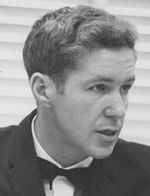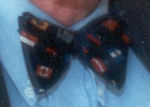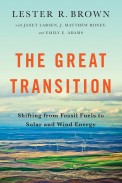Tuesday, July 12, 2011
Earlier this year, in a quiet setting, Lester Brown donated some of his personal items to the Smithsonian Institution’s National Museum of American History. The Museum had asked for memorabilia because of the significant role he has played in the environmental movement. The donations were to say something about him and his work. It took us a while to determine just what would be the best items to give. Since they are now in the hands of the Museum’s curators, we thought you might like to know what we chose. (Read the Museum's blog post.)
Norelco NT II Dictaphone recorder
Lester never learned to type (which is why he also does not use a computer), but he did learn public speaking. Since he didn’t like to write longhand, early in his career, he learned the art of dictation and dictated all of his correspondence and manuscripts. His assistants sometimes took his dictation in shorthand. Lengthy documents such as books, chapters, press releases, articles, and monographs, were first worked out on paper using short phrases or trigger words (see Talk Notes). This process allowed Lester to mentally compose the shape of each paragraph. From this, he would then dictate the piece.
Norelco System 500 transcriber
This transcriber set was used by all of Lester’s assistants since sometime around 1980 through 2008 when the staff succumbed to the digital age and switched to digital transcription equipment. In the interim, everything dictated by Lester went through this machine. The only parts replaced were headsets and ear pads. The first book to be transcribed through this system was Building a Sustainable Society (1981) and the last was Plan B 3.0: Mobilizing to Save Civilization (2008).
Daily Schedule Cards
 Lester at the USDA in a bowtie |
 Lester's bowtie now at the National Museum of American History |
 Lester's current bowtie |
Early in his career, Lester began keeping track of his days through daily schedule cards typed on white index cards, which he carried in his shirt pocket. His assistants typed all relevant information on a card for the events of the day. Lester gets a card for every weekday—even if there is nothing scheduled, which he considers a rare treat. (I told him recently that he is the only person who gets excited about nothing—a blank card!) Last-minute schedule changes are added either by Lester or me. When traveling, he records information on the back of the cards about people he meets or things he needs to do, like send a copy of a book, when he returns to the office. He generally carries a dozen or more cards in his pocket at a time.
Bowtie
Lester keeps his life as simple as possible to save time and to conserve his mental energies. His clothing style reflects this choice and the more demanding his life becomes the simpler his clothing choices, which has become part of his image. Like the running shoes he always wears, bowties are part of this image. The bowtie now at the Museum was sewn from a regular tie given to him by Ted Turner when Turner established the U.N. Foundation, a public charity he created in 1998 with his historic $1 billion gift to support United Nations’ causes and activities. The tie is decorated with flags of selected United Nations members. Since Lester does not wear ties, I refashioned it into a clip-on bowtie for him because that’s he only wears clip-in bow ties. Lester wore this particular bowtie from 1998 through 2002.
Talk Notes (years 1995, 1999, and 2008)
In college, Lester took a required year-long speech course where he learned to use index cards and notes for speeches, rather than reading a fully written out talk. He used index cards until sometime in the late 1970s when he began preparing his talk notes on sheets of blank paper. The two-column, and sometimes 3-column, format became the standard for his talks. This format was and is used to outline all of the major pieces of writing he dictates, including book chapters, monographs, articles, press releases, etc. It is likely that this discipline is what has made him such an engaging speaker.
The talk notes from 1995 were selected because they included presentations he gave when he was squaring off with China. In the 1994 September/October issue of World Watch magazine, Lester published an article entitled “Who Will Feed China?” The article became something akin to the “shot heard ‘round the world.” In 1995, Lester expanded the article into a book of the same name, which only increased the furor. At first the Chinese denounced the analysis, but then reoriented its agricultural price, land use, and water policies. Numerous reassessments were triggered worldwide by Lester’s analysis of China’s food prospect.
The talk notes from 1999 were selected partly to show the amount of travel and the variety of speaking venues Lester accepted. Examples include launching books in other countries, specifically State of the World 1999, Beyond Malthus, and Vital Signs, giving a keynote at the World Meat Congress in Dublin, a donor fundraising trip in California, a meeting in Atlanta to talk over details of a six-part television program initiated by NHK TV through Lester’s contacts, and two trips to Japan. This was also his last year as President of Worldwatch Institute. In 2001, Lester founded the Earth Policy Institute.
The talk notes from 2008 reflect Lester’s depth and breadth as a global analyst and a visionary. He has long been known as an expert in food and population issues. At the Earth Policy Institute, he continues to examine these issues, while significantly adding renewable energy and climate change. His goal for EPI has been to offer a plan for saving civilization. The 2008 talk notes reflect this plan, which he has written of in all of his books beginning with Eco-Economy, and specifically outlined in Plan B 3.0. Plan B is a global effort to stabilize climate by cutting carbon emissions 80 percent by 2020, stabilize population, eradicate poverty, and restore the earth’s natural support systems. Many of the presentations from this year were geared around Plan B. They also indicated a growing interest from a surprising number of financial institutions in what Lester had to say.
Having read this you might now be wondering when you might be able to visit these items at the Museum. We can’t answer that question, but if there is an environmental exhibit at some time—or even one about dictation technologies—you might find some of these pieces of Lester’s life.
And the next time you see Lester, you might take note of his talk notes or daily cards—and don't forget the clip-on bowtie!
Cheers to you all,
Reah Janise Kauffman
Page 1 of 1 pages


